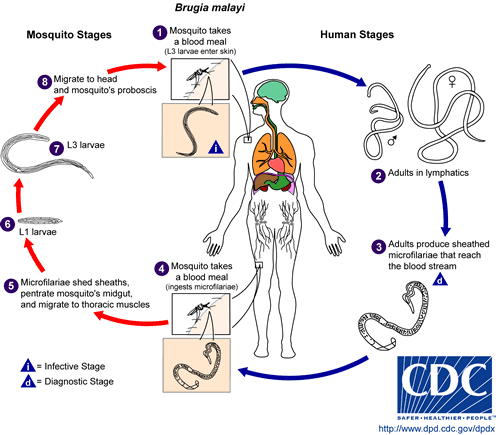Brugia malayi: Difference between revisions
| Line 41: | Line 41: | ||
==Treatment== | ==Treatment== | ||
===Antimicrobial Regimen=== | ===Antimicrobial Regimen=== | ||
:* '''Lymphatic filariasis - Brugia malayi, Brugia timori, Wuchereria bancrofti'''<ref name="pmid20739055">{{cite journal| author=Taylor MJ, Hoerauf A, Bockarie M| title=Lymphatic filariasis and onchocerciasis. | journal=Lancet | year= 2010 | volume= 376 | issue= 9747 | pages= 1175-85 | pmid=20739055 | doi=10.1016/S0140-6736(10)60586-7 | pmc= | url=http://www.ncbi.nlm.nih.gov/entrez/eutils/elink.fcgi?dbfrom=pubmed&tool=sumsearch.org/cite&retmode=ref&cmd=prlinks&id=20739055 }} </ref><ref name="pmid22632644">{{cite journal| author=Knopp S, Steinmann P, Hatz C, Keiser J, Utzinger J| title=Nematode infections: filariases. | journal=Infect Dis Clin North Am | year= 2012 | volume= 26 | issue= 2 | pages= 359-81 | pmid=22632644 | doi=10.1016/j.idc.2012.02.005 | pmc= | url=http://www.ncbi.nlm.nih.gov/entrez/eutils/elink.fcgi?dbfrom=pubmed&tool=sumsearch.org/cite&retmode=ref&cmd=prlinks&id=22632644 }} </ref> | |||
::* Preferred regimen: [[Diethylcarbamazine]] 6 mg/day PO qd for 12 days (single dose if patient will continue to live in endemic area or is younger than 9 years old) {{with or without}} [[Albendazole]] 400 mg PO qd | |||
::* Alternative regimen: [[Doxycycline]] 200 mg/day for 4 weeks {{with or without}} [[Ivermectin]] 150 μg/kg single dose (do not administer [[Ivermectin]] if there's a risk of serious adverse effects in areas where Loa loa is coendemic) | |||
::* Note: Do not administer [[Diethylcarbamazine]] where onchocerciasis is endemic due to the risk of causing severe local inflammation in patients with ocular microfilariae. | |||
==References== | ==References== | ||
Revision as of 16:32, 29 July 2015
| Brugia malayi | ||||||||||||||
|---|---|---|---|---|---|---|---|---|---|---|---|---|---|---|
| B. malayi, blood smear, Giemsa stain. B. malayi, blood smear, Giemsa stain.
| ||||||||||||||
| Scientific classification | ||||||||||||||
| ||||||||||||||
| Binomial name | ||||||||||||||
| Brugia malayi Brug 1927 |
Brugia malayi is a filarial roundworm which causes filariasis in humans.[1] Identified by Lichtenstein and named by Brug in 1927 as distinct from Wuchereria bancrofti, they called it Filaria malayi. In 1958 the separate genus Brugia was proposed by Buckley, and Filaria malayi became known as Brugia malayi.
B. malayi is limited to tropical regions of Asia.
Life cycle

Infective larvae are transmitted by infected biting arthropods during a blood meal. The larvae migrate to the appropriate site of the host's body, where they develop into microfilariae-producing adults. The adults dwell in various human tissues where they can live for several years. The agents of lymphatic filariasis reside in lymphatic vessels and lymph nodes. B. malayi dwells particularly in the lymphatics, as with Wuchereria bancrofti. The female worms produce microfilariae which circulate in the blood.
The microfilariae infect mosquitoes. Inside the mosquito, the microfilariae develop in 1 to 2 weeks into infective filariform (third-stage) larvae. During a subsequent blood meal by the insect, the larvae infect the vertebrate host. They migrate to the lymphatics, where they develop into adults, a slow process that can require up to 18 months.
Recently B. malayi was found to contain an endosymbiotic bacterium, Wolbachia, in all life stages.[2] The genome sequence of this bacterium was determined at New England Biolabs. Experimental results indicate that the Wolbachia can be killed by treatment of the human host with doxycycline. Nematodes cured of the Wolbachia are sterile and have increased morbidity.
Laboratory diagnosis
Identification of microfilariae by microscopic examination is the most practical diagnostic procedure.
Examination of blood samples will allow identification of microfilariae of Brugia malayi. It is important to time the blood collection with the known periodicity of the microfilariae. The blood sample can be a thick smear, stained with Giemsa or hematoxylin and eosin. For increased sensitivity, concentration techniques can be used. These include centrifugation of the blood sample lyzed in 2% formalin (Knott's technique), or filtration through a Nucleopore membrane.
Antigen detection using an immunoassay for circulating filarial antigens constitutes a useful diagnostic approach, because microfilaremia can be low and variable. Molecular diagnosis using polymerase chain reaction is also possible.
Identification of adult worms is possible from tissue samples collected during nodulectomies (onchocerciasis), or during subcutaneous biopsies or worm removal from the eye (loiasis).
Genome deciphered
On September 20, 2007, scientists mapped the genome or genetic content of Brugia malayi, worm which cause elephantiasis (lymphatic filariasis). Figuring out the content of the genes might lead to development of new drugs and vaccines.[3]
Treatment
Antimicrobial Regimen
-
- Preferred regimen: Diethylcarbamazine 6 mg/day PO qd for 12 days (single dose if patient will continue to live in endemic area or is younger than 9 years old) Template:With or without Albendazole 400 mg PO qd
- Alternative regimen: Doxycycline 200 mg/day for 4 weeks Template:With or without Ivermectin 150 μg/kg single dose (do not administer Ivermectin if there's a risk of serious adverse effects in areas where Loa loa is coendemic)
- Note: Do not administer Diethylcarbamazine where onchocerciasis is endemic due to the risk of causing severe local inflammation in patients with ocular microfilariae.
References
- ↑ Cross JH (1996). Filarial Nematodes. In: Baron's Medical Microbiology (Baron S et al, eds.) (4th ed. ed.). Univ of Texas Medical Branch. (via NCBI Bookshelf) ISBN 0-9631172-1-1.
- ↑ Taylor MJ (2002). "A new insight into the pathogenesis of filarial disease". Curr Mol Med. 2 (3): 299–302. PMID 12041732.
- ↑ Reuters, Genome deciphered for elephantiasis-causing worm
- ↑ Taylor MJ, Hoerauf A, Bockarie M (2010). "Lymphatic filariasis and onchocerciasis". Lancet. 376 (9747): 1175–85. doi:10.1016/S0140-6736(10)60586-7. PMID 20739055.
- ↑ Knopp S, Steinmann P, Hatz C, Keiser J, Utzinger J (2012). "Nematode infections: filariases". Infect Dis Clin North Am. 26 (2): 359–81. doi:10.1016/j.idc.2012.02.005. PMID 22632644.
- The article is based on the public domain (U.S. Government website) source US Dept. of Health and Human Services / Center for Disease Control: Filariasis